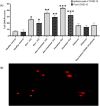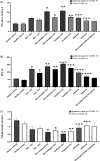Investigating the relationship between lymphocyte cells apoptosis and DNA damage and oxidative stress and therapeutic and clinical outcomes of COVID-19 elderly patients
- PMID: 39251946
- PMCID: PMC11385507
- DOI: 10.1186/s12879-024-09734-x
Investigating the relationship between lymphocyte cells apoptosis and DNA damage and oxidative stress and therapeutic and clinical outcomes of COVID-19 elderly patients
Abstract
Background: While COVID-19 has been controlled and deaths have decreased, the long-term consequences of COVID-19 remain a challenge we face today. This study was conducted to determine the relationship between the apoptosis of lymphocyte cells with DNA damage and oxidative stress and the therapeutic and clinical outcomes of elderly patients with COVID-19.
Methods: This study was conducted from April 2020 to May 2021 (the period of severe attacks of the epidemic peak of COVID-19) and September 2022 (the post-COVID-19 period). The study groups included elderly patients with COVID-19 hospitalized in the ICU and normal wards of the hospital as well as elderly patients with influenza. A polymerase chain reaction was used to check the validity of the studied diseases. The Annexin V/Propidium Iodide method was used to evaluate the level of apoptosis. Genotoxic effects and DNA damage were assessed by the comet assay method. Total antioxidant status (TAS), total oxidant status (TOS), and myeloperoxidase activity (MPO) were measured by photometric methods.
Results: The highest level of apoptosis in peripheral blood lymphocytes and the highest level of DNA damage were observed at both times in the intubated-ICU and non-intubated-ICU groups. In all groups, there was a significant increase in peripheral blood lymphocyte apoptosis levels and DNA damage levels compared to the healthy control group (p < 0.01). The level of apoptosis and DNA damage decreased significantly in the post-COVID-19 period (p < 0.01). In the investigation of oxidative stress biomarkers, the oxidative stress index, including TOS and MPO levels, increased in patients (p < 0.01), and the TAS level decreased (p < 0.01).
Conclusion: It shows that the apoptosis of lymphocyte cells, DNA damage, and oxidative stress can be effective in prognostic decisions and is a suitable predictor for diagnosing the condition of patients with viral infections such as COVID-19 and influenza.
Keywords: Apoptosis; COVID‐19; DNA damage; Flow cytometry; Influenza virus; Lymphocyte; Lymphopenia; MPO; Pandemic; TAS; TOS.
© 2024. The Author(s).
Conflict of interest statement
The authors declare no competing interests.
Figures




Similar articles
-
Investigating DNA damage caused by COVID-19 and influenza in post COVID-19.Mamm Genome. 2025 Mar;36(1):200-212. doi: 10.1007/s00335-024-10082-z. Epub 2024 Nov 14. Mamm Genome. 2025. PMID: 39537997
-
Oxidative stress, DNA damage, and inflammation in COVID-19 patients.North Clin Istanb. 2023 Jun 20;10(3):335-340. doi: 10.14744/nci.2022.00947. eCollection 2023. North Clin Istanb. 2023. PMID: 37435296 Free PMC article.
-
Lymphocyte DNA damage and total antioxidant status in patients with white-coat hypertension and sustained hypertension.Turk Kardiyol Dern Ars. 2008 Jun;36(4):231-8. Turk Kardiyol Dern Ars. 2008. PMID: 18765966
-
Angiotensin II induces reactive oxygen species, DNA damage, and T-cell apoptosis in severe COVID-19.J Allergy Clin Immunol. 2022 Sep;150(3):594-603.e2. doi: 10.1016/j.jaci.2022.06.020. Epub 2022 Jul 14. J Allergy Clin Immunol. 2022. PMID: 35841981 Free PMC article.
-
Peripheral lymphocyte DNA damage and oxidative status after eradication therapy in patients infected with Helicobacter pylori.Pol Arch Med Wewn. 2011 Dec;121(12):428-32. Pol Arch Med Wewn. 2011. PMID: 22012003
Cited by
-
Aging-associated changes in immunological parameters: Implications for COVID-19 immune response in the elderly.Physiol Rep. 2025 May;13(10):e70364. doi: 10.14814/phy2.70364. Physiol Rep. 2025. PMID: 40405557 Free PMC article. Review.
References
MeSH terms
Substances
LinkOut - more resources
Full Text Sources
Medical
Research Materials
Miscellaneous

